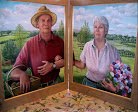 |
| The remains of an unfortunate pigeon |
Murder was done in my garden a few days ago. The wings and feathers of an unfortunate wood pigeon lie strewn over the flowerbed beside the water-filled famine pot where pigeons often come to drink. And I think I know the culprit: next day I spotted the feral cat we often see skulking close by, no doubt hoping for another meal. I wrote murder, but that is the wrong word. The cat was simply doing what God has created cats to do, and deserves no moral blame. Cats kill to eat, and God feeds cats as well as people.
 |
| The culprit - a feral cat |
We all know that a different killer is stalking God’s wider garden just now – the Covid-19 corona virus – and we human beings are its prey.
 |
| Transmission electron microscope image of the corona virus (Credit: NIAID-RM) |
It appears that for most the disease is quite mild. But it kills a proportion of both older people like me and those with pre-existing conditions - though even for these 90% or so will recover. The Chinese and the Koreans seem to have brought it under some control, and we can pray that we in Europe will do so too, but I think most of us will be infected eventually. Lives can be saved if we succeed in reducing the rate that it spreads (‘flattening the curve’), so that the health service is not overwhelmed, and those who need intensive care can get it. This is why it is so important for us to follow official public health guidance. Let us be the good people God has made us to be by doing so, showing God’s love to our neighbours.
I do not fear death. I know I am mortal, but I would like to stay around for a bit yet. I hope to see the grandchildren grow up, perhaps even to welcome their children. Of course I am apprehensive about dying, dreading indignity and suffering, though perhaps Covid-19 is not the worst death. I will accept what comes, but not facilitate it.
The way I see it is this. My life from birth to death is like a piece of 3 dimensional string in the 4 dimensions of space-time, starting at birth and ending in death. My life-string twines around the life-strings of every other person I encounter along the way, including family, friends, neighbours and strangers. God is not constrained by dimensions and sees the whole of my life-string, from birth to death. Love is what pleases God. God judges me as a function of the love I show, both for him and for every person my life-string touches, summed over the whole of my life-string. I know that I often displease God. But despite the times I have displeased him, I believe that God is forgiving and will always love me, always love the whole of my life-string, just as he sees and loves everyone else’s. This, to me, is eternal life, why I do not fear death.
And God’s garden is full of life as well as death. While we humans worry about Covid-19, the natural world burgeons and unfolds as the days lengthen, this year as every year. The buds of Magnolia stellata in my garden have opened already. The pussy willow is yellow with pollen for the bees. And other pigeons are billing and cooing, getting ready to raise a new generation.
 |
| Magnolia stellata bursting into flower |
















